The Ganga & The Panca Prayāg-s
Uttarakhand is the ‘Devabhūmi’ of Bharat, the gateway to the heavens. The Himalayas, the river Ganga, Panca Kedār, Sapta Badrī and numerous other places of historical interest are nestled here. Several great seers and scholars have made Uttarakhand their home. Moreover, the travellers pass through this region while visiting Manasarovar. Several texts of ancient order have been created in this territory. The spiritual and mythological significance of Uttarakhand is immeasurable. Gangotrī, Yamunotrī are part of this region. The glaciers of the Himalayas belong to this state and they nourish the vast Indo-Gangetic plains.
Many great sages and kings including the Pāndavā-s have spent time in the Devabhūmi of our great country. The Ganga flows out of the mountains and several streams knot themselves together in order to give us the river. All the waters found in India are from the same glaciers. The North Eastern monsoon brings the waters from the northern regions into the rest of the country. Scholars and believers alike connect the Himalayas with the tresses of Lord Shiva. The waters are said to flow out of his tresses and then join each other in different places. These confluences are known as ‘Sangaṁ’ or ‘Prayāg’. Such confluences are known as ‘Kooduthurai’ in Tamil. Let us look at the Panca Prayāg-s connected with Ganga.
First of all, let us understand that there are five Prayāg-s and they are - Viṣnuprayāg, Nandaprayāg, Karṇaprayāg, Rudraprayāg and Devaprayāg. Prayāgrāj is the ‘Triveni Sangaṁ’. This was named as Allahabad by the Mughals. The Triveni Sangaṁ was the place where the Ganga, Yamuna and Saraswathi met each other. Since this happens to be the biggest confluence, the place is known as Prayāgrāj. These confluences, ‘Prayāg’ find a place in the Vedās, the Purānā-s, and the Itihāsā-s. Prayāg also means place of sacrifice. Sages and kings used to perform sacrifices in these confluences. The general public is accustomed to spending their time during special occasions and festivals at these divine confluences. They normally celebrate Makara Saṁkrāṁti, Basant Pancami, and Śrī Rāma Navamī with full gusto in these sacred spots.
The clean waters of the Ganga, the valleys and the hills of Uttarakhand, the meandering streams and roads, the local flora and fauna in the company of the ‘Pahādīlog’ (the hill people) would make a visit to these sacred spots absolutely enjoyable. Boats, coracles, and rope bridges had come to the aid of people wishing to cross these sacred waters. A visit to the Panca Prayāg-s was sure to help one cross the waters of Saṁsārā. Ādi Śaṅkarācārya had ensured that people from the South served in the temples of Uttarakhand. Similarly, priests from the North were appointed in the Rāmanātaswāmi Temple in Rameswaram.
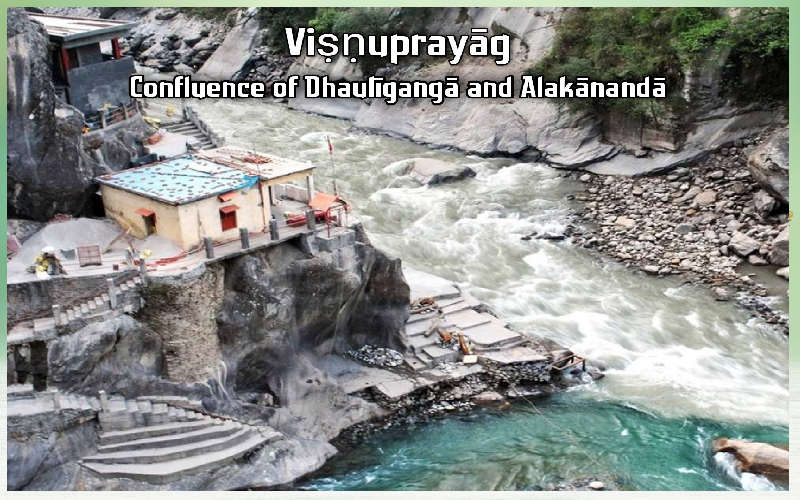
The Panca Prayāg-s are an expression of Hindu religious ethos, specifically meant to connote the five sacred river confluences in the Garhwal Himalayas. Viṣnuprayāg starts with river Alakānandā. This is one of the two source streams of Ganga in the Garhwal Himalayas. The other streams are Dhaulīgangā, Mandākinī, Pinḍar and Bhāgīrati. Alakānandā descends from the foot of the Satopanth (a triangular lake located at a height of 4402 MSL) and is named after the Hindu Trinity - Brahmā, Viṣnu, and Śivā. The Bhāgirath Khārak is also there. This is near the Nandā Devī peak. It cascades over a distance of 229 kilometres encompassing the five Prayāg-s and is joined at Devaprayāg by river Bhāgīrati. Numerous pilgrims visit each of these confluences and large religious towns have sprung up as a result of the same. The faithful take a dip in these holy confluences before embarking upon the visits to temples in the Devabhūmi of our country. All the confluence towns are named after the respective confluences.
Select pilgrims do ablutions before visiting the temple at Badrī. Religious rites to the departed souls are performed in such confluences. The Prayāg-s are not just rich in stories but also rich in terms of scenic beauty. This is the location which is referred to in the Mahābhārata wherein the Pāndavā-s used it to ascend to heaven (Svargārohanā). Viṣnuprayāg is the confluence of Dhaulīgangā and Alakānandā. The Alakānandā flows in front of the sacred Badrīnāth Temple and the Dhaulīgangā originates from the Nītī Pass. This stretch of the Alakānandā is also called Viṣnu Ganga. Sage Nārada had worshipped here, and an octagonal temple located near the confluence is credited to Ahalyā Bāi, the ruler of Indore.
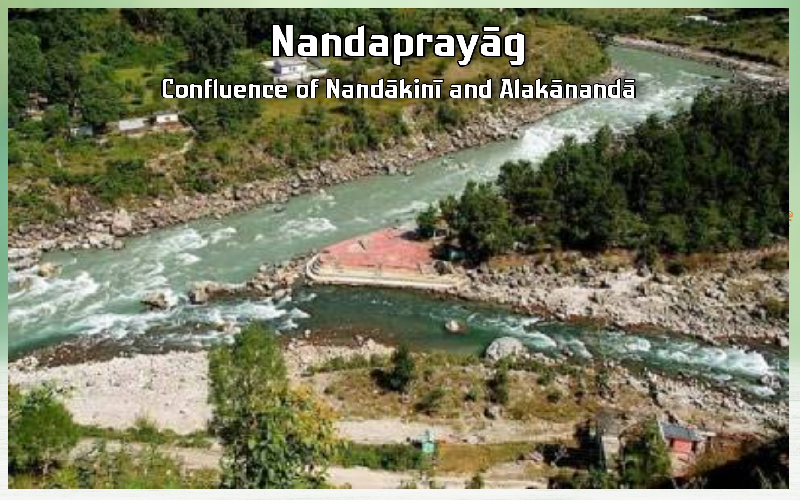
Nandaprayāg is the second of the sacred confluences and it is here that river Nandākinī joins river Alakānandā. It is supposed that long ago, the noble King Nandā had performed a fire sacrifice here and hence it is named after him. There is also a belief which connects this place to Nanda Maharāj, the foster father of Lord Kṛṣṇā. The belief is that the good Lord had promised both the couples - Nandā, Yaśodā & Vasudevā, Devakī that he would be their child. Hence, he is born to one couple and grew up with the other. There is a temple for Gopāl in Nandaprayāg. Ancient lore states that Sage Kanvā had meditated here, and it is here that Duṣyanta married Śakuntalā.
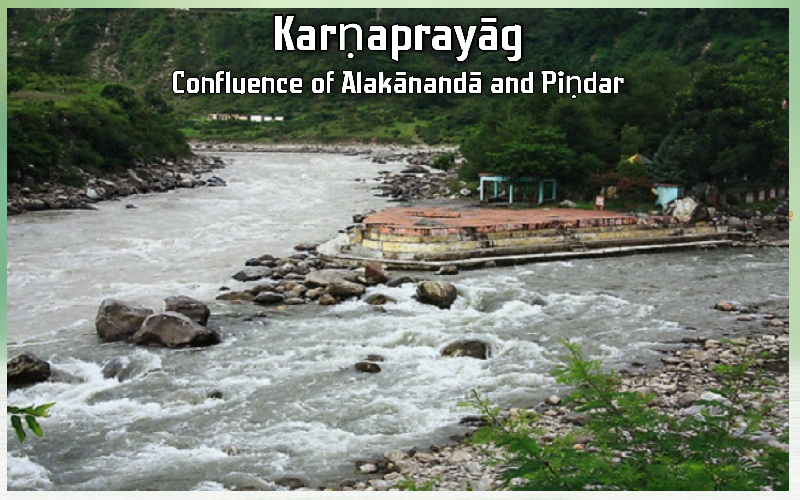
Karṇaprayāg is the third confluence, and it is here that river Alakānandā is joined by river Pinḍar. This river originates from the Pinḍar glacier and this is located below the Nandā Devi mountain range. Karṇā, a warrior from the Mahabharata is said to have meditated here in order to earn his protective gear - the Kavacā (armour) and Kuṇdalā (earrings). This happens to be the reason for this name. There is a reference to this place in the ‘Meghadūta’ of Kālidāsā. The ‘Abhijñāna Śākuntalaṃ’ mentions this as the romantic spot which witnessed the dalliances between Duṣyanta and Śakuntalā. It is posited that Swami Vivekānanda had meditated here for 18 days. A stone temple is built here, thanks to Ādi Śaṅkarā and the icons of Pārvati, Śivā, Gaṇeśa, and Karṇā. A steep row of steps from the temple leads to the confluence. The shrines in this spot are important. There is a ‘Bināyak Śilā’ (Ganesha idol) which is supposed to protect people from danger.
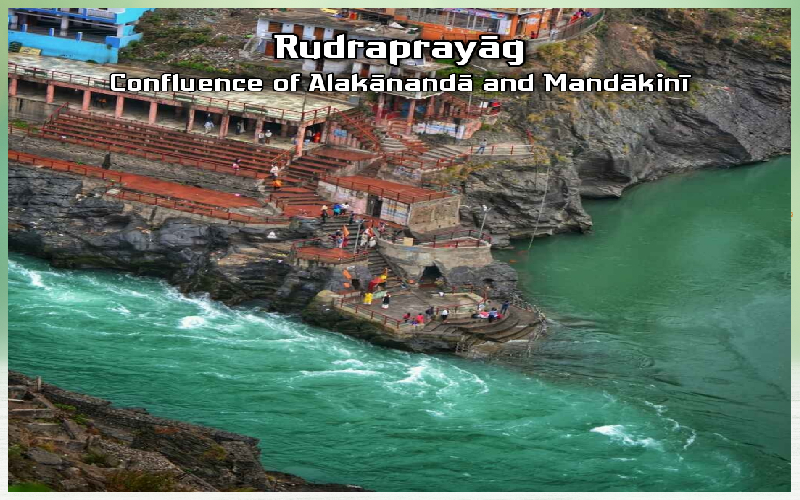
River Alakānandā meets river Mandākinī at Rudraprayāg. It is believed Lord Śiva had performed his Tānḍava here and hence the name. The Tānḍava is a vigorous dance which happens to be the source of creation, preservation, and dissolution. It is also said that Lord Śiva had played his Rudra Vīṇā here and enticed Lord Viṣnu to his presence in order to convert him into water. Another legend talks about Lord Viṣnu taming the ego of the Vīṇā playing Sage, Nāradā. Lord Kṛṣṇā tells Nāradā that Śiva and Pārvati are impressed by his Vīṇā skills. Therefore, Nāradā sets out to meet the divine couple. He meets a number of beautiful Rāgini-s (musical notes which formed the Rāgā-s) who had got disfigured. They tell him that this was because of Sage Nāradā playing the Vīṇā. This gives him a chance to realize, and he surrenders before Lord Śiva and becomes a disciple. Yet another legend says that Pārvati was born here. The temples of Rudranāth and Goddess Cāmuṇḍā are located here.
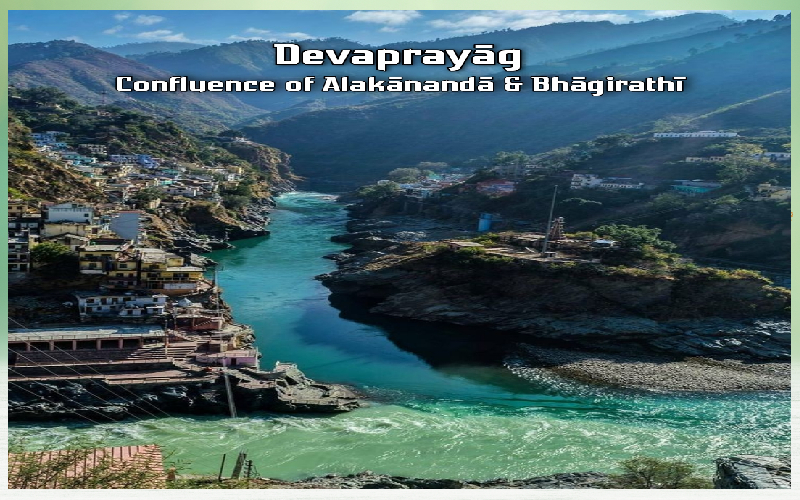
Devaprayāg is the last of the Panca prayāg-s. It is the confluence of the rivers Bhāgīrathī and Alakānandā. This Prayāg is the first one on the way to Badrīnāth. It is from here that the waters are known as Ganga. The holiness of this place is equal to Triveni Sangaṁ. Bhāgīrathī moves with full force and meets the calm Alakānandā in Devaprayāg. It is accepted that the Brāhmin, Deva Śarmā had performed austerities here and was blessed by Lord Rāma, hence the name. The two Kuṇḍ-s (ponds) on the banks of the rivers are known as Vaśiṣta Kuṇḍ (Bhāgīrathī) and Brahma Kuṇḍ (Alakānandā). It is also said that this site happens to be the navel of Lord Viṣnu and Lord Brahmā had meditated here. A number of other stories are connected with Devaprayāg, Lord Rāma had performed penance here in order to atone for the killing of Rāvaṇa, a Brāhmin. It can be observed that Mahābalī had been entreated by Lord Vāmanā here for the 3 steps of land.
Vaishnavaites consider Devaprayāg as one of the 108 Divya Desams as per the Rāmānuja Saṁpradāya. The famous temple of Lord Rāma called the Raghunāth Maṭh is located here. A 15 tall black granite image of Lord Rāma is offered worship here and it is believed to be more than 1250 years old. Lots of ancient inscriptions can be noticed in Devaprayāg. These inscriptions date the temple to the first century of the common era. While Devaprayāg is located at a distance of 70 kilometres from Ṛṣikeśa, Rudraprayāg is 140 km, Karṇaprayāg is 169 km, Nandaprayāg is 190 km and Viṣnuprayāg via Jośimaṭh is 256 km.
Swami Haridās Girī who was known for his bhajan traditions and deep devotion disappeared in the confluence. He took to Jalasamādī in full consciousness in front of his devotees. Even now his presence was believed to be manifest at Koṭesvar. This place was near Rudraprayāg. There was Hindu Temple dedicated to Koṭesvar Mahādev here and Swami Nāmānanda Girī, the main disciple of Swami Haridās Girī built a Bhajan platform and dedicated it to him. Swami Haridās Girī was the disciple of Swami Jñānanda Girī.
The Panca prayāg-s are in the Himalayan region and it is best to visit them during the non-winter times. All of them can be accessed by road. A mere reading of the stories connected with Panca prayāg-s motivate the religious to visit them and the associated shrines. Visiting the Panca Kedār and the Sapta Badrī are a must for every Indian. Every Bhāratīya believes that nature is part of divinity and therefore reveres it.
Viṣnuprayāg, Nandaprayāg, Karṇaprayāg, Rudraprayāg and Devaprayāg are beacons of our belief system.
NEXT ARTICLE